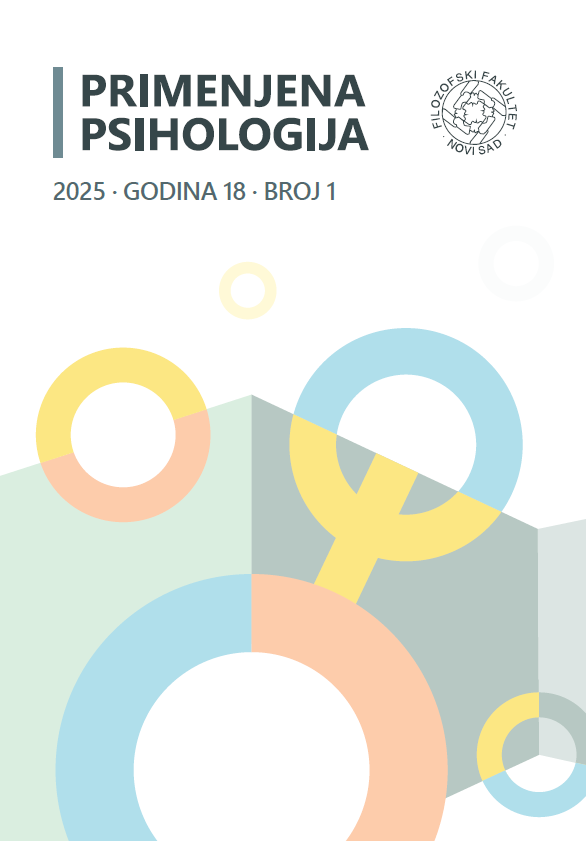Investigating the Links between Physical Activity, Emotion Regulation, and Mental Health: Comparison in Active, Recreational, and Non-athletes
DOI:
https://doi.org/10.19090/pp.v18i1.2561Ključne reči:
physical activity, mental health, emotion regulation, distressApstrakt
This research aimed to investigate the relationship between physical activity and mental health, focusing on the potential mediating role of emotional regulation. We investigated whether physical activity predicts the degree of distress and whether this potentially significant relationship can be mediated by two strategies of emotion regulation - cognitive reappraisal and emotional suppression. Then, we tested the mentioned mediation model within three subsamples − active athletes, recreational athletes, and non-athletes. A mediation analysis conducted on the entire sample revealed the existence of partial mediation. In addition to the significant total effect, physical activity had a significant direct effect on distress and a significant indirect effect through both tested emotion regulation strategies. More physical activity predicts more use of cognitive reappraisal, which then predicts lower distress. Also, more physical activity predicts more use of emotional suppression, which predicts higher distress. Such results suggest that engaging in physical activity can lead to a decrease and an increase in distress, depending on which emotion regulation strategy a person relies on. Mediation analyses conducted on subsamples provided arguable confirmation of the mediation model only in the case of recreational athletes. The results obtained within the subsamples are discussed in detail.
Reference
Baron, R. M., & Kenny, D. A. (1986). The moderator-mediator variable distinction in social psychological research: conceptual, strategic, and statistical considerations. Journal of Personality and Social Psychology, 51(6), 1173–1182. https://doi.org/10.1037/0022-3514.51.6.1173 DOI: https://doi.org/10.1037//0022-3514.51.6.1173
Booker, C. L., Skew, A. J., Sacker, A., & Kelly, Y. J. (2014). Well-being in adolescence − an association with health-related behaviors. The Journal of Early Adolescence, 34(4), 518–538. https://doi.org/10.1177/0272431613501082 DOI: https://doi.org/10.1177/0272431613501082
Cairney, J., Faulkner, G., Veldhuizen, S., & Wade, T. J. (2009). Changes over time in physical activity and psychological distress among older adults. The Canadian Journal of Psychiatry, 54(3), 160–169. https://doi.org/10.1177/070674370905400304 DOI: https://doi.org/10.1177/070674370905400304
Caspersen, C. J., Powell, K. E., & Christenson, G. M. (1985). Physical activity, exercise, and physical fitness: definitions and distinctions for health-related research. Public Health Reports, 100(2), 126–131.
Chekroud, S. R., Gueorguieva, R., Zheutlin, A. B., Paulus, M., Krumholz, H. M., Krystal, J. H., et al. (2018). Association between physical exercise and mental health in 1.2 million individuals in the USA between 2011 and 2015: a cross-sectional study. Lancet Psychiatry, 5(9), 739–746. https://doi.org/10.1016/s2215-0366(18)30227-x DOI: https://doi.org/10.1016/S2215-0366(18)30227-X
Cutuli, D. (2014). Cognitive reappraisal and expressive suppression strategies role in the emotion regulation: an overview on their modulatory effects and neural correlates. Frontiers in Systems Neuroscience, 8, 175. https://doi.org/10.3389/fnsys.2014.00175 DOI: https://doi.org/10.3389/fnsys.2014.00175
Edwards, M. K., Rhodes, R. E., Mann, J. R., & Loprinzi, P. D. (2018). Effects of acute aerobic exercise or meditation on emotional regulation. Physiology & Behavior, 186, 16–24. https://doi.org/10.1016/j.physbeh.2017.12.037 DOI: https://doi.org/10.1016/j.physbeh.2017.12.037
Field, A. (2013). Discovering statistics using IBM SPSS statistics (4th ed.). SAGE Publications.
Fletcher, D., & Arnold, R. (2017). Stress in sport: the role of the organizational environment. In C. R. D. Wagstaff (Ed.), The organizational psychology of sport: key issues and practical applications (pp. 83–100). Routledge/Taylor & Francis Group.
Fuentealba-Urra, S., Rubio, A., González-Carrasco, M., Oyanedel, J. C., & Céspedes‑Carreno, C. (2023). Mediation effect of emotional self-regulation in the relationship between physical activity and subjective well-being in Chilean adolescents. Scientific Reports, 13, 13386. https://doi.org/10.1038/s41598-023-39843-7 DOI: https://doi.org/10.1038/s41598-023-39843-7
Games, P. A., & Howell, J. F. (1976). Pairwise multiple comparison procedures with unequal n's and/or variances: a Monte Carlo study. Journal of Educational and Behavioral Statistics, 1(2), 113–125. https://doi.org/10.3102/10769986001002113 DOI: https://doi.org/10.3102/10769986001002113
Garnefski, N., Van Den Kommer, T., Kraaij, V., Teerds, J., Legerstee, J., & Onstein, E. (2002). The relationship between cognitive emotion regulation strategies and emotional problems: comparison between a clinical and a non-clinical sample. European Journal of Personality, 16(5), 403–420. https://doi.org/10.1002/per.458 DOI: https://doi.org/10.1002/per.458
Godin, G. (2011). The Godin-Shephard leisure-time physical activity questionnaire. Health & Fitness Journal of Canada, 4(1), 18–22. https://doi.org/10.14288/hfjc.v4i1.82
Gross, J. J. (1998). Antecedent- and response-focused emotion regulation: divergent consequences for experience, expression, and physiology. Journal of Personality and Social Psychology, 74(1), 224–237. https://doi.org/10.1037/0022-3514.74.1.224 DOI: https://doi.org/10.1037//0022-3514.74.1.224
Gross, J. J., & John, P. O. (2003). Individual differences in two emotion regulation processes: implications for affect, relationships, and well-being. Journal of Personality and Social Psychology, 85(2), 348–362. https://doi.org/10.1037/0022-3514.85.2.348 DOI: https://doi.org/10.1037/0022-3514.85.2.348
Gross, J. J., & Thompson, R. (2007). Emotion regulation: conceptual foundations. In J. J. Gross (Ed.), Handbook of emotion regulation (pp. 3–24). The Guilford Press.
Gross, J. J., Richards, J. M., & John, O. P. (2006). Emotion regulation in everyday life. In D. K. Snyder, J. Simpson, & J. N. Hughes (Eds.), Emotion regulation in couples and families: pathways to dysfunction and health (pp. 13–35). American Psychological Association. DOI: https://doi.org/10.1037/11468-001
Gucciardi, D. F., Law, K. H., Guerrero, M. D., Quested, E., Thøgersen-Ntoumani, C., Ntoumanis, N., & Jackson, B. (2019). Longitudinal relations between psychological distress and moderate-to-vigorous physical activity: a latent change score approach. Psychology of Sport and Exercise, 47, 101490. https://doi.org/10.1016/j.psychsport.2019.02.005 DOI: https://doi.org/10.1016/j.psychsport.2019.02.005
Hair, J. F., Black, W. C., Babin, B. J., & Anderson, R. E. (2010). Multivariate data analysis (7th ed.). Prentice-Hall.
Hayes, A. F. (2022). Introduction to mediation, moderation, and conditional process analysis: a regression-based approach (3rd ed.). The Guilford Press.
Lovibond, S. H., & Lovibond, P. F. (1995). Manual for the depression anxiety & stress scales (2nd ed.). Psychology Foundation. DOI: https://doi.org/10.1037/t01004-000
Martin, J. C., & Wade, T. J. (2000). The relationship between physical exercise and distress in a national sample of Canadians. Canadian Journal of Public Health, 91(4), 302–306. https://doi.org/10.1007/BF03404294 DOI: https://doi.org/10.1007/BF03404294
Mauss I. B., Bunge, A. S., & Gross, J. J. (2007). Automatic emotion regulation. Social and Personality Psychology Compass, 1(1), 146−167. https://doi.org/10.1111/j.1751-9004.2007.00005.x DOI: https://doi.org/10.1111/j.1751-9004.2007.00005.x
Mizrahi, D., Swain, C. T. V., Bruinsma, F., Hodge, A., Taylor, N., & Lynch, B. M. (2023). The relationship between psychological distress and physical activity is non-linear and differs by domain: a cross-sectional study. International Journal of Behavioral Medicine, 30(5), 673–681. https://doi.org/10.1007/s12529-022-10130-5 DOI: https://doi.org/10.1007/s12529-022-10130-5
Neta, M., Harp, N. R., Henley, D. J., Beckford, S. E., & Koehler, K. (2019). One step at a time: physical activity is linked to positive interpretations of ambiguity. PloS One, 14(11), e0225106. https://doi.org/10.1371/journal.pone.0225106 DOI: https://doi.org/10.1371/journal.pone.0225106
Ochsner, K. N., & Gross, J. J. (2005). The cognitive control of emotion. Trends in Cognitive Sciences, 9(5), 242−249. https://doi.org/10.1016/j.tics.2005.03.010 DOI: https://doi.org/10.1016/j.tics.2005.03.010
Perchtold-Stefan, C. M., Fink, A., Rominger, C., Weiss, E. M., & Papousek, I. (2020). More habitual physical activity is linked to the use of specific, more adaptive cognitive reappraisal strategies in dealing with stressful events. Stress and Health: Journal of the International Society for the Investigation of Stress, 36(3), 274–286. https://doi.org/10.1002/smi.2929 DOI: https://doi.org/10.1002/smi.2929
Popov, S., Janičić, B., & Dinić, B. (2016). Validation of the Serbian version of the Emotion Regulation Questionnaire (ERQ). Primenjena Psihologija, 9(1), 63–81. https://doi.org/10.19090/pp.2016.1.63-81 DOI: https://doi.org/10.19090/pp.2016.1.63-81
Popov, S., Sokić, J., & Stupar, D. (2021). Activity matters: physical exercise and stress coping during COVID–19 state of emergency. Psihologija, 54(3), 307–322. https://doi.org/10.2298/PSI200804002P DOI: https://doi.org/10.2298/PSI200804002P
Popov, S., Volarov, M., & Rakočević, N. (2023). The relationship between physical activity and mental health: is more always better? Primenjena Psihologija, 16(3), 349-374. https://doi.org/10.19090/pp.v16i3.2461 DOI: https://doi.org/10.19090/pp.v16i3.2461
Rebar, A. L., Stanton, R., Geard, D., Short, C., Duncan, M. J., & Vandelanotte, C. (2015). A meta-meta-analysis of the effect of physical activity on depression and anxiety in non-clinical adult populations. Health Psychology Review, 9(3), 366–378. https://doi.org/10.1080/17437199.2015.1022901 DOI: https://doi.org/10.1080/17437199.2015.1022901
Scheewe, T. W., Jörg, F., Takken, T., Deenik, J., Vancampfort, D., Backx, F. J. G., & Cahn, W. (2019). Low physical activity and cardiorespiratory fitness in people with schizophrenia: a comparison with matched healthy controls and associations with mental and physical health. Frontiers in Psychiatry, 10, 87. https://doi.org/10.3389/fpsyt.2019.00087 DOI: https://doi.org/10.3389/fpsyt.2019.00087
Schuch, F. B., Vancampfort, D., Firth, J., Rosenbaum, S., Ward, P. B., Silva, E. S., … Stubbs, B. (2018). Physical activity and incident depression: a meta-analysis of prospective cohort studies. American Journal of Psychiatry, 175(7), 631–648. https://doi.org/10.1176/appi.ajp.2018.17111194 DOI: https://doi.org/10.1176/appi.ajp.2018.17111194
Stubbs, B., Vancampfort, D., Smith, L., Rosenbaum, S., Schuch, F., & Firth, J. (2018). Physical activity and mental health. The Lancet Psychiatry, 5(11), 873. https://doi.org/10.1016/S2215-0366(18)30343-2 DOI: https://doi.org/10.1016/S2215-0366(18)30343-2
Teychenne, M., White, R. L., Richards, J., Schuch, F. B., Rosenbaum, S., & Bennie, J. A. (2020). Do we need physical activity guidelines for mental health: what does the evidence tell us? Mental Health and Physical Activity, 100315. https://doi.org/10.1016/j.mhpa.2019.100315 DOI: https://doi.org/10.1016/j.mhpa.2019.100315
Wicker, P., & Frick, B. (2015). The relationship between intensity and duration of physical activity and subjective well-being. European Journal of Public Health, 25(5), 868–872. https://doi.org/10.1093/eurpub/ckv131 DOI: https://doi.org/10.1093/eurpub/ckv131
Wiese, C. W., Kuykendall, L., & Tay, L. (2017). Get active? A meta-analysis of leisure-time physical activity and subjective well-being. The Journal of Positive Psychology, 13(1), 57–66. https://doi.org/10.1080/17439760.2017.1374436 DOI: https://doi.org/10.1080/17439760.2017.1374436
Yang, M., Wu, J., Wu, Y., & Li, X. (2024). How does physical activity enhance the subjective well-being of university students? A chain mediation of cognitive reappraisal and resilience. Behavioral Sciences, 14(3), 164. https://doi.org/10.3390/bs14030164 DOI: https://doi.org/10.3390/bs14030164
Zhang, Y., Fu, R., Sun, L., Gong, Y., & Tang, D. (2019). How does exercise improve implicit emotion regulation ability: preliminary evidence of mind-body exercise intervention combined with aerobic jogging and mindfulness-based yoga. Frontiers in Psychology, 10, 1888. https://doi.org/10.3389/fpsyg.2019.01888 DOI: https://doi.org/10.3389/fpsyg.2019.01888
Zschucke, E., Gaudlitz, K., & Ströhle, A. (2013). Exercise and activity in mental disorders: clinical and experimental evidence. Journal of Preventive Medicine and Public Health, 46(1), 12–21. https://doi.org/10.3961/jpmph.2013.46.s.s12 DOI: https://doi.org/10.3961/jpmph.2013.46.S.S12
Downloads
Objavljeno
Kako citirati
Broj časopisa
Sekcija
Licenca
Sva prava zadržana (c) 2025 Nikolija Rakočević, Stanislava Popov, Dragana Brdarić Leka

Ovaj rad je pod Creative Commons Autorstvo 4.0 Internacionalna licenca.







